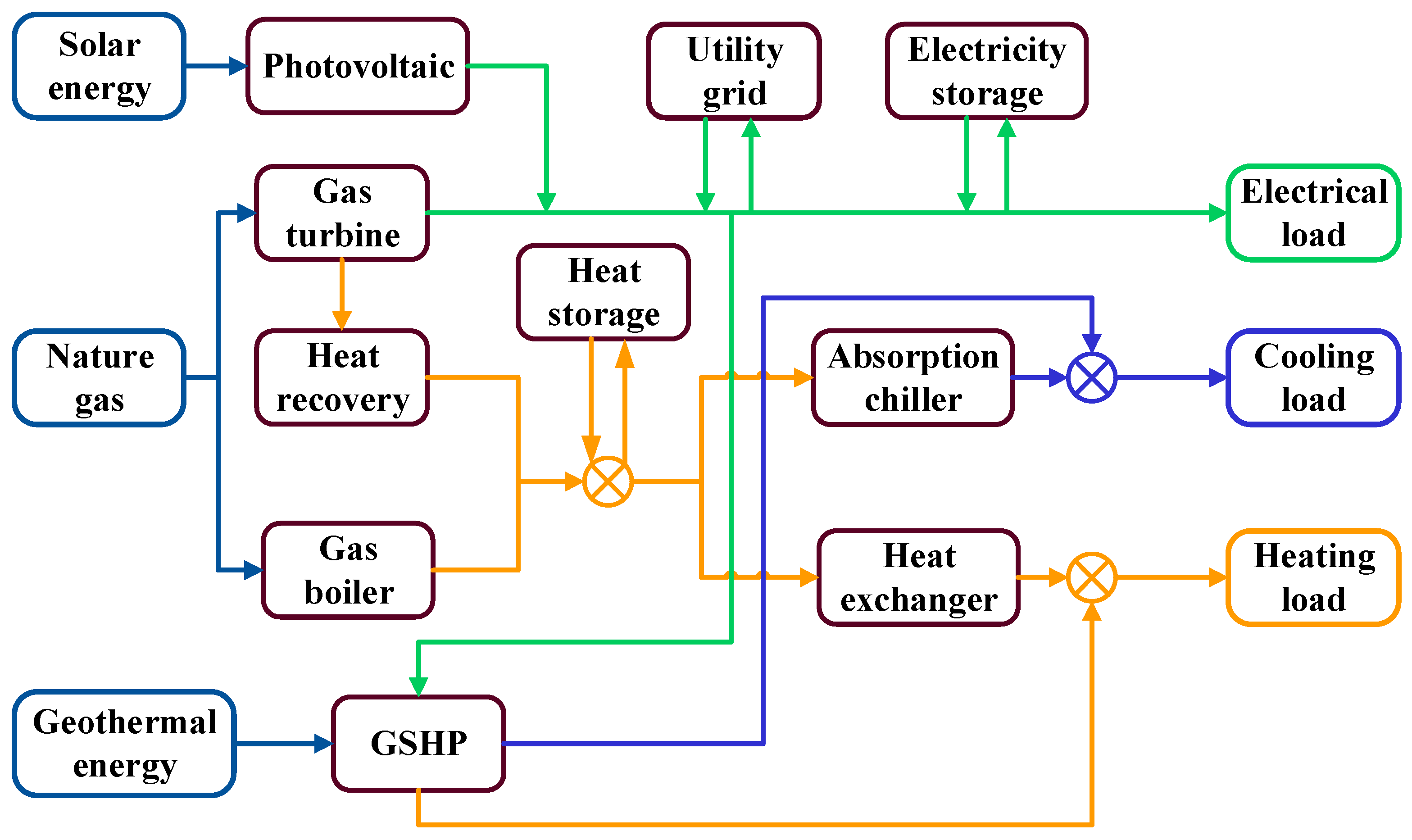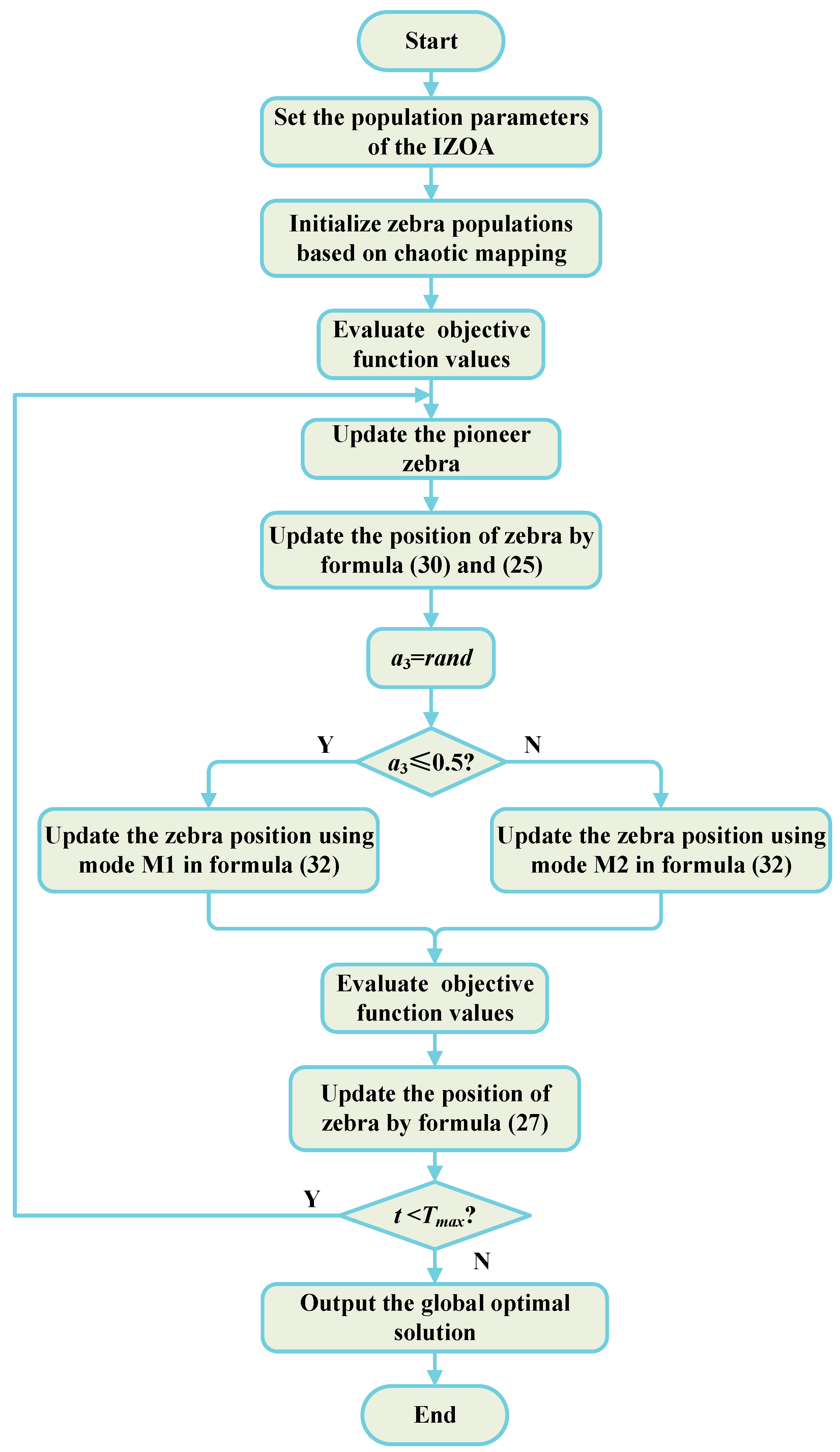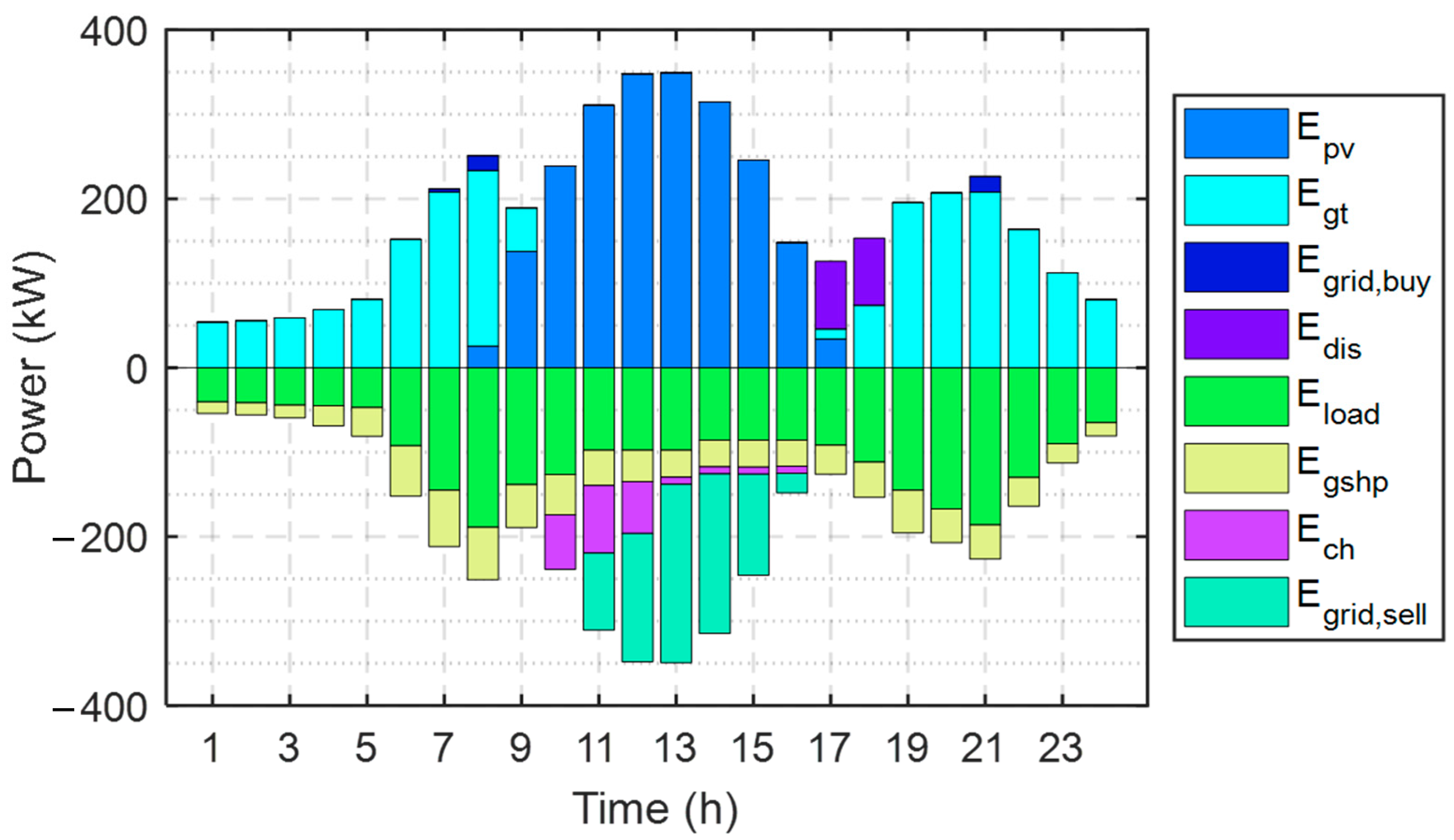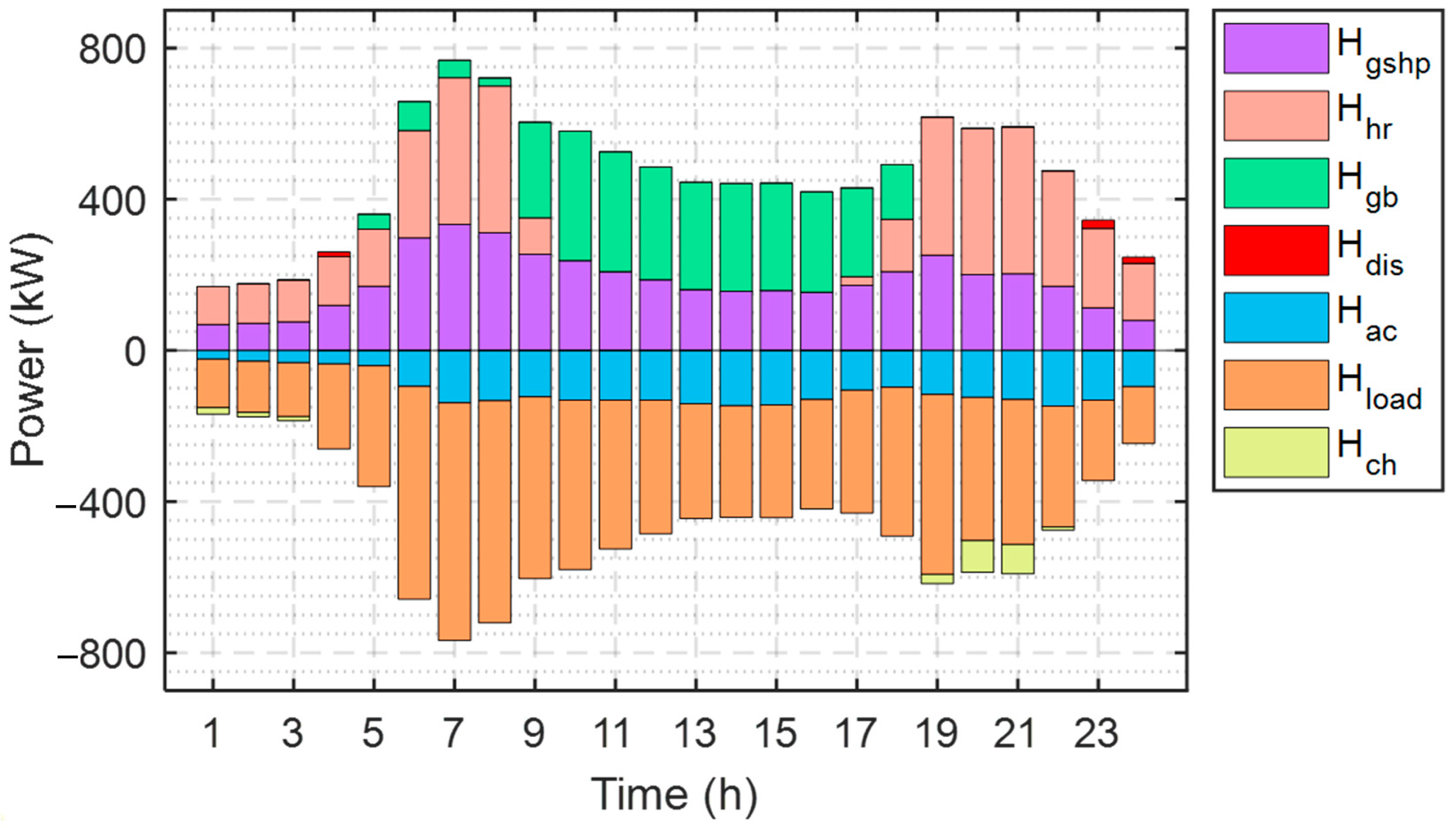Renewable Energy Distributed Energy System Optimal Configuration and Performance Analysis: Improved Zebra Optimization Algorithm
Abstract
1. Introduction
- A novel DES structure with a simultaneous application of PV, GSHP and energy storage technologies is proposed;
- A DES optimization model is constructed, which takes into account the emissions of SO2, CO2 and NOx, and reduces the pollutant emissions by 69.90% compared with the conventional SP energy supply system;
- An IZOA incorporating a sinusoidal cosine strategy, tent chaotic initialization and dynamic adaptive weighting is proposed, which improves the ECSR by up to 13.31% and the PERR by up to 17.57% compared to the comparison algorithms.
2. Literature Review
2.1. Distributed Energy System
2.2. Optimization Algorithm
3. Distributed Energy System
3.1. System Description
3.2. DES Energy Balance
3.2.1. Cooling Balance
3.2.2. Heating Balance
3.2.3. Electricity Balance
3.3. Operation Strategy
3.4. Objective Function
4. Optimization Algorithm
4.1. Zebra Optimization Algorithm
- (1)
- Population initialization and fitness calculation
- (2)
- Foraging behavior
- (3)
- Defending strategy
4.2. Improved Zebra Optimization Algorithm
- (1)
- Tent chaotic mapping initialization population
- (2)
- Sine cosine strategy
- (3)
- Dynamic adaptive weight factor
- (1)
- Set the population parameters of IZOA, including dimensionality, number of zebras, and maximum number of iterations;
- (2)
- Initialize the zebra population using tent mapping;
- (3)
- Calculate the individual zebra fitness values and record the optimal zebra positions;
- (4)
- Update the individual zebra positions by incorporating the foraging formula of the sine cosine strategy;
- (5)
- Generate a random number a3 and select the defending mode according to a3. If , update the zebra position using mode M1 in the update Formula (32) with the addition of dynamic adaptive weights; if , the zebra updates the zebra position using mode M2 in Formula (32);
- (6)
- Calculate the fitness value of all zebras, update the zebra position through Formula (27) and save the global optimal solution;
- (7)
- Determine whether the iteration termination condition is reached. If the condition is reached, the global optimal solution is output, and the IZOA is ended. If the termination condition is not satisfied, step (4) is returned for loop iteration.
4.3. Performance Analysis of IZOA
5. Case Analysis
5.1. Case Description
5.2. Optimization Results
6. Concluding Remarks
- The IZOA algorithm incorporating the sine and cosine strategy, chaotic initialization, and dynamic adaptive weighting factors exhibits excellent convergence speed and superior global search capability on both single-peak and multi-peak test functions;
- The DES minimum cost, fuel consumption, and pollutant emission in FEL mode are USD 198,568.92, 1,650,039.44 kWh, and 366,994.87 kg, which are 13.03%, 60.71%, and 69.90% lower compared with the conventional SP energy supply system;
- The DES optimized using IZOA improves the ECSR by 13.31%, 0.17%, and 0.26%, the PERR by 17.57%, 4.72%, and 0.11%, and the ESR by 16.22%, 6.26%, and 0.12%, compared to the DES configured using the GWO, SCA, and ZOA algorithms. Additionally, the convergence speed of the IZOA is significantly better than that of other algorithms in solving the DES configuration optimization problem.
Author Contributions
Funding
Data Availability Statement
Conflicts of Interest
References
- Nadeem, T.B.; Siddiqui, M.; Khalid, M.; Asif, M. Distributed energy systems: A review of classification, technologies, applications, and policies. Energy Strategy Rev. 2023, 48, 101096. [Google Scholar] [CrossRef]
- Wu, Y.; Meng, D. Synchronizability-Based Distributed Learning Control for Multi-Agent Systems. IEEE Trans. Circuits Syst. Ii Express Briefs 2024, 71, 2109–2113. [Google Scholar] [CrossRef]
- Hong, T.; Zhang, Y.; Liu, J.; Zhao, D.; Xiong, J. Distributed Data-Driven Optimization for Voltage Regulation in Distribution Systems. IEEE Trans. Power Syst. 2024, 39, 1263–1273. [Google Scholar] [CrossRef]
- Ji, B.-X.; Liu, H.-H.; Cheng, P.; Ren, X.-Y.; Pi, H.-D.; Li, L.-L. Phased optimization of active distribution networks incorporating distributed photovoltaic storage system: A multi-objective coati optimization algorithm. J. Energy Storage 2024, 91, 112093. [Google Scholar] [CrossRef]
- Yin, L.; Tao, M. Balanced broad learning prediction model for carbon emissions of integrated energy systems considering distributed ground source heat pump heat storage systems and carbon capture & storage. Appl. Energy 2023, 329, 120269. [Google Scholar]
- Liu, C.; Yue, X.; Shi, K.; Sun, Z. Chapter 1—Introduction of basic knowledge. In Spacecraft Attitude Control; Liu, C., Yue, X., Shi, K., Sun, Z., Eds.; Elsevier: Amsterdam, The Netherlands, 2022; pp. 1–35. [Google Scholar]
- Liu, C.; Yue, X.; Zhang, J.; Shi, K. Active Disturbance Rejection Control for Delayed Electromagnetic Docking of Spacecraft in Elliptical Orbits. IEEE Trans. Aerosp. Electron. Syst. 2022, 58, 2257–2268. [Google Scholar] [CrossRef]
- Huang, C.; Yan, Y.; Madonski, R.; Zhang, Q.; Deng, H. Improving operation strategies for solar-based distributed energy systems: Matching system design with operation. Energy 2023, 276, 127610. [Google Scholar] [CrossRef]
- Wang, J.; Deng, H.; Qi, X. Cost-based site and capacity optimization of multi-energy storage system in the regional integrated energy networks. Energy 2022, 261, 125240. [Google Scholar] [CrossRef]
- Wang, Y.W.; Zhang, Y.; Liu, X.K.; Chen, X. Distributed Predefined-time Optimization and Control for Multi-bus DC Microgrid. IEEE Trans. Power Syst. 2024, 1–11. [Google Scholar] [CrossRef]
- Li, J.; Xiao, Y.; Lu, S. Optimal configuration of multi microgrid electric hydrogen hybrid energy storage capacity based on distributed robustness. J. Energy Storage 2024, 76, 109762. [Google Scholar] [CrossRef]
- Liu, J.; Rao, Z.; Liu, G.; Liao, S. Promotion of distributed energy system considering capacity allocation optimization and multi-stakeholder decision-making behaviors. J. Clean. Prod. 2024, 437, 140464. [Google Scholar] [CrossRef]
- Cao, Y.; Wang, Q.; Wang, Z.; Jermsittiparsert, K.; Shafiee, M. A new optimized configuration for capacity and operation improvement of CCHP system based on developed owl search algorithm. Energy Rep. 2020, 6, 315–324. [Google Scholar] [CrossRef]
- Taghikhani, M.A.; Khamseh, J. Multi-objective optimal energy management of storage system and distributed generations via water cycle algorithm concerning renewable resources uncertainties and pollution reduction. J. Energy Storage 2022, 52, 104756. [Google Scholar] [CrossRef]
- Deng, Y.; Liu, Y.; Zeng, R.; Wang, Q.; Li, Z.; Zhang, Y.; Liang, H. A novel operation strategy based on black hole algorithm to optimize combined cooling, heating, and power-ground source heat pump system. Energy 2021, 229, 120637. [Google Scholar] [CrossRef]
- Han, H.; Zhang, H.; Yang, J.; Yang, L. Distributed Containment Control Strategy for the Dynamic Stabilization of Integrated Energy System with Multiple Virtual Leaders. IEEE Trans. Ind. Inform. 2024, 20, 6642–6651. [Google Scholar] [CrossRef]
- Nazloo, H.T.; Babazadeh, R.; Varmazyar, M. Optimal Configuration and Planning of Distributed Energy Systems Considering Renewable Energy Resources. J. Environ. Inform. 2024, 43, 50–64. [Google Scholar]
- Yuan, Z.-P.; Li, P.; Li, Z.-L.; Xia, J. A Fully Distributed Privacy-Preserving Energy Management System for Networked Microgrid Cluster Based on Homomorphic Encryption. IEEE Trans. Smart Grid 2024, 15, 1735–1748. [Google Scholar] [CrossRef]
- Sadeghi, R.; Sadeghi, S.; Memari, A.; Rezaeinejad, S.; Hajian, A. A peer-to-peer trading model to enhance resilience: A blockchain-based smart grids with machine learning analysis towards sustainable development goals. J. Clean. Prod. 2024, 450, 141880. [Google Scholar] [CrossRef]
- Lee, C.-C.; Yan, J. Will artificial intelligence make energy cleaner? Evidence of nonlinearity. Appl. Energy 2024, 363, 123081. [Google Scholar] [CrossRef]
- Wang, J.; Han, Z.; Guan, Z. Hybrid solar-assisted combined cooling, heating, and power systems: A review. Renew. Sustain. Energy Rev. 2020, 133, 110256. [Google Scholar] [CrossRef]
- Liu, T.; Liu, Q.; Lei, J.; Sui, J. A new solar hybrid clean fuel-fired distributed energy system with solar thermochemical conversion. J. Clean. Prod. 2019, 213, 1011–1023. [Google Scholar] [CrossRef]
- Zhang, D.; Zhang, R.; Zhang, B.; Zheng, Y.; An, Z. Environment dominated evaluation modeling and collocation optimization of a distributed energy system based on solar and biomass energy. Renew. Energy 2023, 202, 1226–1240. [Google Scholar] [CrossRef]
- Xue, K.; Wang, J.; Hu, G.; Wang, S.; Zhao, Q.; Chong, D.; Yan, J. Optimal planning for distributed energy systems with carbon capture: Towards clean, economic, independent prosumers. J. Clean. Prod. 2023, 414, 137776. [Google Scholar] [CrossRef]
- Deng, Y.; Liu, Y.; Zhang, Y.; Zeng, R.; Zheng, Z.; Yao, Y.; Wu, L.; Gong, Z.; Liu, S. Optimization and performance analysis of CCHP-GSHP-SE system under different start factors. Energy Convers. Manag. 2022, 266, 115827. [Google Scholar] [CrossRef]
- Ashrafi, N.; Ahmadi, R.; Zahedi, A. Technical, economical, and environmental scenario based modeling of the building equipped with ground source heat pump (GSHP) and solar system. Energy Build. 2023, 289, 113048. [Google Scholar] [CrossRef]
- Lasemi, M.A.; Arabkoohsar, A.; Hajizadeh, A.; Mohammadi-ivatloo, B. A comprehensive review on optimization challenges of smart energy hubs under uncertainty factors. Renew. Sustain. Energy Rev. 2022, 160, 112320. [Google Scholar] [CrossRef]
- Ma, H.; Sun, Q.; Chen, Q.; Zhao, T.; He, K. Exergy-based flexibility cost indicator and spatio-temporal coordination principle of distributed multi-energy systems. Energy 2023, 267, 126572. [Google Scholar] [CrossRef]
- Ge, Y.; Han, J.; Ma, Q.; Feng, J. Optimal configuration and operation analysis of solar-assisted natural gas distributed energy system with energy storage. Energy 2022, 246, 123429. [Google Scholar] [CrossRef]
- Li, C.; Wang, L.; Zhang, Y.; Yu, H.; Wang, Z.; Li, L.; Wang, N.; Yang, Z.; Maréchal, F.; Yang, Y. A multi-objective planning method for multi-energy complementary distributed energy system: Tackling thermal integration and process synergy. J. Clean. Prod. 2023, 390, 135905. [Google Scholar] [CrossRef]
- Fan, W.; Fan, Y.; Yao, X.; Yi, B.; Jiang, D.; Wu, L. Distributed transaction optimization model of multi-integrated energy systems based on nash negotiation. Renew. Energy 2024, 225, 120196. [Google Scholar] [CrossRef]
- Su, Y.; Wu, S.; Wang, Z.; Bao, Z.; Liu, F. Hierarchically Distributed Energy Management in Distribution Systems: An Error-Tolerant and Asynchronous Approach. IEEE Trans. Smart Grid 2024, 15, 2909–2920. [Google Scholar] [CrossRef]
- Babaei, M.A.; Hasanzadeh, S.; Karimi, H. Cooperative energy scheduling of interconnected microgrid system considering renewable energy resources and electric vehicles. Electr. Power Syst. Res. 2024, 229, 110167. [Google Scholar] [CrossRef]
- Xu, X.F.; Wang, K.; Ma, W.H.; Huang, X.R.; Ma, Z.X.; Li, Z.H. Multi-objective particle swarm optimization algorithm based on multi-strategy improvement for hybrid energy storage optimization configuration. Renew. Energy 2024, 223, 120086. [Google Scholar] [CrossRef]
- Toopshekan, A.; Ahmadi, E.; Abedian, A.; Rad, M.A.V. Techno-economic analysis, optimization, and dispatch strategy development for renewable energy systems equipped with Internet of Things technology. Energy 2024, 296, 131176. [Google Scholar] [CrossRef]
- Moser, A.; Muschick, D.; Gölles, M.; Nageler, P.; Schranzhofer, H.; Mach, T.; Ribas Tugores, C.; Leusbrock, I.; Stark, S.; Lackner, F.; et al. A MILP-based modular energy management system for urban multi-energy systems: Performance and sensitivity analysis. Appl. Energy 2020, 261, 114342. [Google Scholar] [CrossRef]
- Huang, D.; Zhou, D.; Jia, X.; Yan, S.; Li, T.; Huang, D.; Zhang, C. A mixed integer optimization method with double penalties for the complete consumption of renewable energy in distributed energy systems. Sustain. Energy Technol. Assess. 2022, 52, 102061. [Google Scholar] [CrossRef]
- Tian, Z.; Li, X.; Niu, J.; Zhou, R.; Li, F. Enhancing operation flexibility of distributed energy systems: A flexible multi-objective optimization planning method considering long-term and temporary objectives. Energy 2024, 288, 129612. [Google Scholar] [CrossRef]
- Hou, H.; Xu, T.; Wu, X.; Wang, H.; Tang, A.; Chen, Y. Optimal capacity configuration of the wind-photovoltaic-storage hybrid power system based on gravity energy storage system. Appl. Energy 2020, 271, 115052. [Google Scholar] [CrossRef]
- Huang, P.; Sun, Y.; Lovati, M.; Zhang, X. Solar-photovoltaic-power-sharing-based design optimization of distributed energy storage systems for performance improvements. Energy 2021, 222, 119931. [Google Scholar] [CrossRef]
- Gao, M.; Han, Z.; Zhang, C.; Li, P.; Wu, D.; Li, P. Optimal configuration for regional integrated energy systems with multi-element hybrid energy storage. Energy 2023, 277, 127672. [Google Scholar] [CrossRef]
- Li, B.; Hu, P.; Zhu, N.; Lei, F.; Xing, L. Performance analysis and optimization of a CCHP-GSHP coupling system based on quantum genetic algorithm. Sustain. Cities Soc. 2019, 46, 101408. [Google Scholar] [CrossRef]
- Dai, Y.; Zeng, Y. Optimization of CCHP integrated with multiple load, replenished energy, and hybrid storage in different operation modes. Energy 2022, 260, 125129. [Google Scholar] [CrossRef]
- Song, Z.; Liu, T.; Lin, Q. Multi-objective optimization of a solar hybrid CCHP system based on different operation modes. Energy 2020, 206, 118125. [Google Scholar] [CrossRef]
- Hou, H.; Wu, J.; Ding, Z.; Yang, B.; Hu, E. Performance analysis of a solar-assisted combined cooling, heating and power system with an improved operation strategy. Energy 2021, 227, 120516. [Google Scholar] [CrossRef]
- Wang, J.; Ren, X.; Zhang, S.; Xue, K.; Wang, S.; Dai, H.; Chong, D.; Han, X. Co-optimization of configuration and operation for distributed multi-energy system considering different optimization objectives and operation strategies. Appl. Therm. Eng. 2023, 230, 120655. [Google Scholar] [CrossRef]
- Liang, J.F.; Fan, H.; Cheng, L.; Rong, S.Y.; Li, T.C.; Yu, T.K.; Wang, L.B. Control strategy for improving the frequency response characteristics of photovoltaic and energy storage systems based on VSG control. Energy Rep. 2024, 11, 2295–2305. [Google Scholar] [CrossRef]
- Zhang, Z.-L.; Zhang, H.-J.; Xie, B.; Zhang, X.-T. Energy scheduling optimization of the integrated energy system with ground source heat pumps. J. Clean. Prod. 2022, 365, 132758. [Google Scholar] [CrossRef]
- Trojovska, E.; Dehghani, M.; Trojovsky, P. Zebra Optimization Algorithm: A New Bio-Inspired Optimization Algorithm for Solving Optimization Algorithm. IEEE Access 2022, 10, 49445–49473. [Google Scholar] [CrossRef]
- Wei, F.T.; Zhang, Y.Y.; Li, J.Y. Multi-strategy-based adaptive sine cosine algorithm for engineering optimization problems. Expert Syst. Appl. 2024, 248, 123444. [Google Scholar] [CrossRef]
- Lian, Z.C.; Shu, J.G.; Zhang, Y.; Sun, J. Convergent Grey Wolf Optimizer Metaheuristics for Scheduling Crowdsourcing Applications in Mobile Edge Computing. IEEE Internet Things J. 2024, 11, 1866–1879. [Google Scholar] [CrossRef]
- Zhou, C.W.; Liu, G.; Liao, S.M. Probing dominant flow paths in enhanced geothermal systems with a genetic algorithm inversion model. Appl. Energy 2024, 360, 122841. [Google Scholar] [CrossRef]
- Zhang, Z.P.; Fu, Y.P.; Gao, K.Z.; Zhang, H.; Wang, L. A cooperative evolutionary algorithm with simulated annealing for integrated scheduling of distributed flexible job shops and distribution. Swarm Evol. Comput. 2024, 85, 101467. [Google Scholar] [CrossRef]
- Li, L.L.; Ji, B.X.; Lim, M.K.; Tseng, M.L. Active distribution network operational optimization problem: A multi-objective tuna swarm optimization model. Appl. Soft Comput. 2024, 150, 111087. [Google Scholar] [CrossRef]
- Ren, F.; Lin, X.; Wei, Z.; Zhai, X.; Yang, J. A novel planning method for design and dispatch of hybrid energy systems. Appl. Energy 2022, 321, 119335. [Google Scholar] [CrossRef]
- Li, L.-L.; Ren, X.-Y.; Tseng, M.-L.; Wu, D.-S.; Lim, M.K. Performance evaluation of solar hybrid combined cooling, heating and power systems: A multi-objective arithmetic optimization algorithm. Energy Convers. Manag. 2022, 258, 115541. [Google Scholar] [CrossRef]










| Function | Range | Dim | Fmin |
|---|---|---|---|
| [−100, 100] | 30 | 0 | |
| [−10, 10] | 30 | 0 | |
| [−500, 500] | 30 | −418.9829 × 30 | |
| [−5, 5] | 4 | 0 |
| Algorithms | Parameters |
|---|---|
| SCA | α = 2, N = 30 |
| GWO | a = 2 t × (2/Tmax), N = 30 |
| GA | N = 30 |
| SA | N = 30 |
| ZOA | R = 0.1, N = 30 |
| IZOA | R = 0.1, β = 0.4, k = 1.5, N = 30 |
| Function | Algorithm | Avg | Std | Best | Worst |
|---|---|---|---|---|---|
| F1 | SCA | 3.30 × 10−2 | 1.29 × 10−1 | 2.69 × 10−7 | 5.81 × 10−1 |
| GWO | 5.15 × 10−59 | 9.34 × 10−59 | 2.26 × 10−61 | 3.44 × 10−58 | |
| GA | 1.68 × 10−2 | 8.41 × 10−3 | 1.01 × 10−2 | 2.98 × 10−2 | |
| SA | 3.05 × 103 | 4.97 × 103 | 1.02 × 102 | 2.73 × 104 | |
| ZOA | 0.00 × 100 | 0.00 × 100 | 0.00 × 100 | 0.00 × 100 | |
| IZOA | 0.00 × 100 | 0.00 × 100 | 0.00 × 100 | 0.00 × 100 | |
| F2 | SCA | 5.74 × 10−5 | 1.97 × 10−4 | 8.61 × 10−8 | 8.84 × 10−4 |
| GWO | 1.11 × 10−34 | 1.28 × 10−34 | 7.47 × 10−36 | 4.44 × 10−34 | |
| GA | 4.97 × 10−2 | 1.05 × 10−2 | 9.67 × 10−3 | 6.83 × 10−2 | |
| SA | 8.94 × 101 | 2.41 × 101 | 3.34 × 101 | 1.03 × 102 | |
| ZOA | 3.63 × 10−265 | 0.00E + 00 | 5.02 × 10−273 | 3.68 × 10−264 | |
| IZOA | 0.00 × 100 | 0.00 × 100 | 0.00 × 100 | 0.00 × 100 | |
| F3 | SCA | −3.87 × 103 | 3.09 × 102 | −4.55 × 103 | −3.31 × 103 |
| GWO | −5.98 × 103 | 8.09 × 102 | −7.56 × 103 | −4.11 × 103 | |
| GA | −1.13 × 104 | 3.09 × 102 | −1.15 × 104 | −1.11 × 104 | |
| SA | −7.20 × 103 | 6.38 × 102 | −7.99 × 103 | −7.10 × 103 | |
| ZOA | −6.84 × 103 | 7.05 × 102 | −8.07 × 103 | −5.43 × 103 | |
| IZOA | −1.14 × 104 | 1.91 × 103 | −1.26 × 104 | −7.63 × 103 | |
| F4 | SCA | 1.12 × 10−3 | 3.31 × 10−4 | 5.61 × 10−4 | 1.51 × 10−3 |
| GA | 1.72 × 10−3 | 4.39 × 10−3 | 1.32 × 10−3 | 2.13 × 10−3 | |
| SA | 1.51 × 10−2 | 2.20 × 10−2 | 1.09 × 10−2 | 1.77 × 10−2 | |
| GWO | 1.51 × 10−3 | 4.46 × 10−3 | 3.07 × 10−4 | 2.04 × 10−2 | |
| ZOA | 1.31 × 10−3 | 4.48 × 10−3 | 3.07 × 10−4 | 2.04 × 10−2 | |
| IZOA | 4.42 × 10−4 | 1.32 × 10−4 | 3.24 × 10−4 | 7.87 × 10−4 |
| Equipment | Symbols | Values |
|---|---|---|
| GT | 0.30 | |
| HR | 0.80 | |
| HE GSHP | 0.80 | |
| 4.00 | ||
| 5.89 | ||
| GB AC ES | 0.80 | |
| 0.70 | ||
| 0.04 | ||
| 0.95 | ||
| HS | 0.04 | |
| 0.8 |
| Items | Representatives | Values |
|---|---|---|
| Unit investment price (USD/kW) | GT | 1046 |
| GB | 25 | |
| GSHP | 373 | |
| AC | 216 | |
| PV | 2039 | |
| HE | 22 | |
| ES | 487 | |
| HS | 32.8 | |
| Electricity price (USD/kWh) | Peak period (6:00–22:00) | 0.171 |
| Valley period (23:00–5:00) | 0.101 | |
| Natural gas price (USD/kWh) | – | 0.0464 |
| Items | Symbol | Value (g/kWh) |
|---|---|---|
| Utility grid | γCO2,e | 968 |
| γSO2,e | 3.12 | |
| γNOx,e | 2.35 | |
| γCO2,g | 200 | |
| Natural gas | γSO2,g | 0.0009 |
| γNOx,g | 0.619 |
| Items | Symbol | Value |
|---|---|---|
| GT capacity | Ngt | [0, 400] |
| PV capacity | Npv | [0, 400] |
| ES capacity | NES | [0, 1000] |
| HS capacity | NHS | [0, 1000] |
| GB capacity | NGB | [0, 1000] |
| Heating ratio of GSHP | kh | [0, 1] |
| Cooling ratio of GSHP | kc | [0, 1] |
| Items | GWO | SCA | ZOA | IZOA |
|---|---|---|---|---|
| Economic cost (USD) | 228,368.68 | 198,980.37 | 199,174.45 | 198,568.92 |
| Pollutant emission (kg) | 581,200.92 | 424,629.87 | 368,350.14 | 366,994.87 |
| Fuel consumption (kWh) | 2,330,738.65 | 1,912,459.16 | 1,654,882.95 | 1,650,039.44 |
| ECSR (%) | −0.0116 | 12.86 | 12.77 | 13.03 |
| PERR (%) | 52.33 | 65.18 | 69.79 | 69.90 |
| ESR (%) | 44.49 | 54.45 | 60.59 | 60.71 |
| Items | GT/kW | PV/kW | ES/kW | HS/kW | GB/kW | kh | kc |
|---|---|---|---|---|---|---|---|
| Value | 282.6 | 400 | 208 | 793.7 | 912.3 | 0.53 | 0.81 |
Disclaimer/Publisher’s Note: The statements, opinions and data contained in all publications are solely those of the individual author(s) and contributor(s) and not of MDPI and/or the editor(s). MDPI and/or the editor(s) disclaim responsibility for any injury to people or property resulting from any ideas, methods, instructions or products referred to in the content. |
© 2024 by the authors. Licensee MDPI, Basel, Switzerland. This article is an open access article distributed under the terms and conditions of the Creative Commons Attribution (CC BY) license (https://creativecommons.org/licenses/by/4.0/).
Share and Cite
Qi, Z.; Peng, S.; Wu, P.; Tseng, M.-L. Renewable Energy Distributed Energy System Optimal Configuration and Performance Analysis: Improved Zebra Optimization Algorithm. Sustainability 2024, 16, 5016. https://doi.org/10.3390/su16125016
Qi Z, Peng S, Wu P, Tseng M-L. Renewable Energy Distributed Energy System Optimal Configuration and Performance Analysis: Improved Zebra Optimization Algorithm. Sustainability. 2024; 16(12):5016. https://doi.org/10.3390/su16125016
Chicago/Turabian StyleQi, Zhaoyu, Shitao Peng, Peisen Wu, and Ming-Lang Tseng. 2024. "Renewable Energy Distributed Energy System Optimal Configuration and Performance Analysis: Improved Zebra Optimization Algorithm" Sustainability 16, no. 12: 5016. https://doi.org/10.3390/su16125016
APA StyleQi, Z., Peng, S., Wu, P., & Tseng, M.-L. (2024). Renewable Energy Distributed Energy System Optimal Configuration and Performance Analysis: Improved Zebra Optimization Algorithm. Sustainability, 16(12), 5016. https://doi.org/10.3390/su16125016







